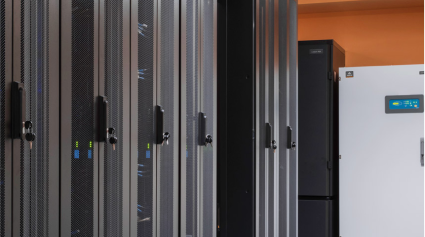It took a pandemic to unleash business appetite for edge computing, but now there’s no going back. Healthcare organizations enabled telemedicine services; education organizations started and scaled remote learning; government agencies offered COVID-19 relief payments and other services; and retailers adapted fast to changing consumer habits, including online ordering and flexible delivery. In addition, organizations are embracing flexible hybrid work models across all industries, providing employees with more choice and voice in where and how they work. It’s not an overstatement to say that edge computing’s all-star moment has arrived, which is one reason spending on this technology is slated to soar to $250.6 billion in 2024.
So, what’s in store for edge computing in the near future? In our new white paper, Enterprise to Edge: Speeding Deployment and Management of Complex IT Infrastructures, we examine some key trends your IT and facilities teams are grappling with today.
More Edge Sites Means More Devices to Manage
Your data center, IT and infrastructure teams are managing more devices and sites than ever, while your user experience and business requirements have skyrocketed. Your device footprint includes:
- Production, development and test servers
- Non-essential servers
- Administrative desktops
- Storage devices
- Networking equipment
- Remote rack power distribution units (rPDUs), remote uninterruptible power supplies (UPS) and sensors
- Rack door locks
- Cameras
- Other devices
These trends include:
- IT infrastructures are growing. During the pandemic, 46% of all organizations increased hybrid cloud investments to enable remote workforces, scale digital services and push computing resources closer to users for a better experience. The race to the cloud and the edge has become a sprint.
- 5G wireless will enable new applications: 5G will increase speeds by a factor of 10X, enabling processing of vast amounts of edge data with minimal latency. That makes it possible for you to power Internet of Things (IoT) applications and capitalize on automation and analytics driven by artificial intelligence (AI) and machine learning (ML) more easily.
- IT management is becoming more complex. IT teams need secure, remote access to a wide array of equipment, which is increasingly packaged with vendor tools, increasing management complexity. Your team may struggle to keep pace with tool proliferation in an industry that favors speed, simplicity and scale.
- IT site access is not guaranteed. During the pandemic, most IT work has been done remotely. IT teams may or may not have access to sites such as colocated facilities, while all facilities have likely reduced the number of staff on site. In addition, it is typically not feasible or desirable to send IT staff or local providers out to edge sites on a moment’s notice.
As a result, your IT team is thinking strategically about how to manage your growing IT footprint, which includes everything from network and server closets to micro and modular data centers.
If you’re still using manual processes, your IT team is experiencing significant work strain. In addition, the possibility of errors increases as staff responsibilities grow. Finally, misconfigured devices could create security gaps, while inattention to alerts could lead to critical equipment damage or failures.
Fortunately, there’s a better way to manage all the IT devices you’re responsible for. You can deploy a robust, scalable solution to monitor and control your entire IT infrastructure, remotely and securely. You’ll be able to support user and device growth flexibly and rapidly, including use cases where your staff need 4K streaming access. Finally, you can tap embedded Linux firmware to make critical improvements and improve your operational efficiency over time.
Edge computing is here, and growth is happening faster than expected. Get ready to scale your management approach now with insights in from Enterprise to Edge: Speeding Deployment and Management of Complex IT Infrastructures.



